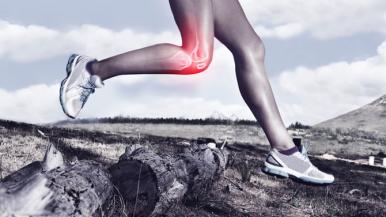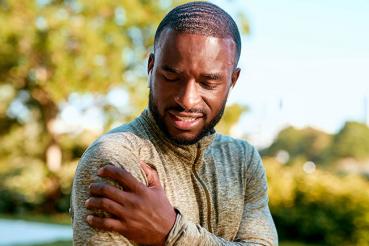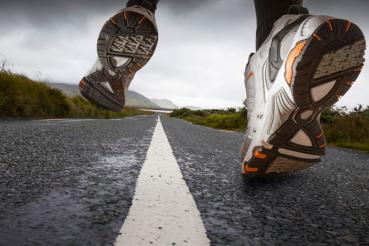As the largest joint in your body, the knee takes on its fair share of impact. So not surprisingly, knee pain is a common complaint among people of all ages.
The most common reasons for painful knees include inflammation caused by improper lifting of heavy objects, poor flexibility, bad shoes, muscle weakness, starting high-impact fitness routines without warming up and structural knee problems, such as arthritis, torn cartilage or ligament damage.
"People who have inflammation issues almost always respond to physical therapy, medication or rehabilitation and almost never require surgery," says Charles Bush-Joseph, MD, a sports medicine surgeon at Rush. "But those with structural issues are more likely to need some kind of surgery or arthroscopic surgery to repair the damage."
So how can you tell the difference between inflammation and structural problems? According to Bush-Joseph, people who are able to extend their knees straight without pain typically have less serious inflammation issues. Whereas people often have structural damage when their knees are visibly swollen or they cannot get into a squatting position with their knees at 90-degree angles.
"Knee pain can happen to anyone at any age," says Bush-Joseph. "Usually if patient's knees are swollen and they are in pain, I have them ice the knees, stretch and take some anti-inflammatory medications for seven to 10 days. If their knees are still visibly and persistently swollen for longer than that, that warrants further evaluation, including imaging tests like an X-ray or MRI."
Of course, prevention is always the best medicine. Here, Bush-Joseph offers five tips for preventing knee pain and keeping your knees strong and healthy:
1. Don't skip the exercise, even if you have a structural problem.
The key is to know your limits. Strength training that focuses heavily on building up muscles in the quadriceps and hamstrings can decrease pain and help people better tolerate arthritis and other structural knee problems. Staying active helps control weight and build muscle, both of which can help protect your knees from further damage.
The best exercises for people with structural knee problems include nonimpact aerobic exercises, such as walking on level ground, training on an elliptical machine, using a stationary bike, swimming and doing water aerobics. It’s also wise to avoid activities that put extra stress on the knees such as kneeling, deep knee bends and downhill running.
2. Whether you're active or not, stretching is good for the knees.
Stretches that focus on the calf, hamstring and quadriceps muscles take pressure off of the knees and kneecaps. "Many people often say there is no aerobic value in stretching, so they see it as a waste of time," says Bush-Joseph. "But a well-conditioned, flexible body is less likely to develop overuse problems in the knees."
Some good stretches to protect the knees include step-ups, hamstring curls and straight-leg lifts. Additionally, stretches that focus on building flexibility in the hips, including a butterfly stretch and a standing hip flexor with a resistance band, can help alleviate knee pain.
People who do not like to stretch before a workout can still protect their knees by slowly ramping up to top speed rather than jumping full speed into their workout.
A well-conditioned, flexible body is less likely to develop overuse problems in the knees.
"Warming up the muscles helps prevent injury," says Bush-Joseph. "If you like to run but you don't have the time to warm-up and stretch out, you should start your run with 10 to 15 minutes of walking or slow jogging before getting up to peak velocity."
Here's how to do these exercises and stretches:
- Step-ups: Stand in front of a small step stool or stairs and lift your body onto the step using one leg. Then step backward down the step with the same leg. Do 10 to 15 step-ups per leg.
- Hamstring curls: Lie on your stomach with your legs straight and your head resting on your arms or the ground. Bend one leg with the heel toward your buttocks. Repeat 10 to 15 times and then switch legs.
- Straight-leg lifts: Lie on the floor on your back, with one leg bent at a 90-degree angle and your foot flat on the ground. Lift the other leg off the ground. Repeat 10 to 15 times and then switch legs.
- Butterfly stretch: Sit up straight with the soles of your feet pressed together. Holding your feet, slowly lean your upper body forward (keeping your back straight). Hold the stretch for 30 seconds to one minute.
- Standing hip flexor: Get into a stride position (body and feet facing forward with one foot stepped further in front). Stand up straight with your abdominal muscles tightened. Keeping your back straight, slowly lunge forward with the front leg. Hold the stretch for 30 seconds to one minute and then switch legs.
3. Losing weight can improve knee pain.
"Your weight plays a major role in knee pain," says Bush-Joseph. "If you walked around all day with a backpack that had a 10-pound weight in it, you would feel how achy your back, hips and knees are at the end of the day. That shows you the impact extra weight can have on your joints."
With each step people take, two to four times their body weight is transmitted through the knee joint, according to Bush-Joseph. Thus, the more you weigh, the harder the impact is on your knee joint.
However, people who are overweight and have arthritic knee pain can lessen the impact — and ultimately, relieve knee pain — by losing weight. In fact, people with arthritic knees lose about 20 percent of their pain with every 10 pounds of weight loss.
"If you are 20 pounds overweight and you have arthritic knee pain, almost half of your pain will go away by losing 20 pounds," says Bush-Joseph. Of course, losing 20 pounds isn't easy. But, if people are able to lose even 10 pounds and add in some stretching and flexibility training, they'll experience significantly less pain, according to Bush-Joseph.
4. Wearing the proper shoes is important for healthy knees.
Supportive and comfortable shoes help take pressure off the knee joint by promoting proper leg alignment and balance. So it's no surprise that wearing high heels is a common cause of knee pain.
"When high heels lift your heel up, your weight bearing line tips forward so your quadriceps have to work harder to hold your knee straight, which then leads to knee pain," says Bush-Joseph. "Whereas, if your heel is closer to the floor in low pumps or flats, your thigh muscles don't have to work as hard to maintain stability, which is easier on the knees."
While strength training and stretching can help build up the muscles around the knees to minimize knee damage from heels, it's best to save the stilettos for special occasions.
Proper shoes are particularly important during exercise. "If you are taking up running as a newbie or starting a new form of aerobic exercise, getting professionally fitted from someone at a running or sporting goods store can help with knee problems and will certainly lower your incidence of having overuse problems due to footwear," says Bush-Joseph.
5. Stand up straight to feel better.
"When you slouch you are leaning forward and walking bent over at the waist — and that posture will lead to knee pain," says Bush-Joseph. "You want your head centered over your shoulders and your shoulders centered over your abdomen and pelvis. The more your body is off-center, the more you have to compensate for that with muscle activity. Those muscles eventually fatigue, causing strain on your joints."
Having strong core muscles in your abdomen and lower back helps promote good posture and, ultimately, lessens the pressure on your knees. Exercises such as planks, back extensions, yoga and Pilates can help strengthen the core.
Here’s how to do these exercises:
- Planks: Lie face down with your toes pointed to the floor. Put your forearms on the floor with your elbows at 90-degree angles. Tighten your abdominal and gluteal muscles and lift your body off the floor. Keep your back straight and hold for 15 to 45 seconds.
- Back extensions: Lie face down with elbows bent and hands on the floor. Keeping your hips on the floor, lift your head and shoulders up with your arms. Hold for 5 to 10 seconds and repeat five to 10 times.




